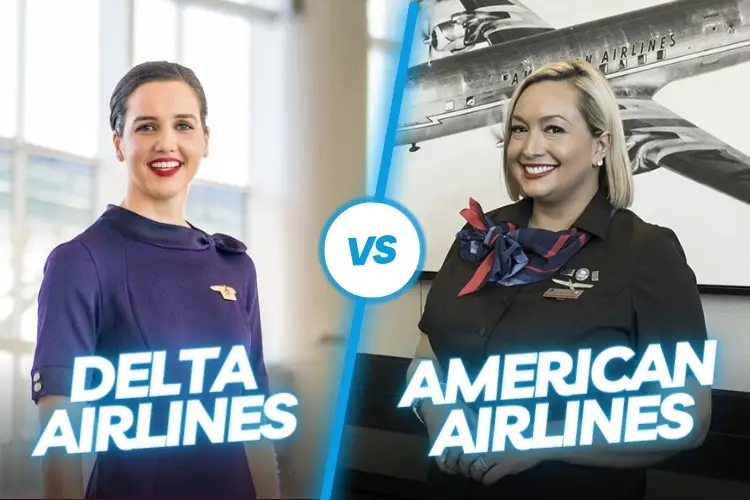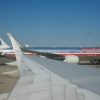In 2017 I was standing in the terminal of Dallas Fort Worth (DFW) having just received my conditional job offer (CJO) from American Airlines when I got a call from Delta. I had interviewed with them a week earlier in Atlanta. They were reaching out to offer me a CJO too and were willing to give me 24 hours to decide if I would accept it or stay with American.
Let’s be clear, this is an unusual situation to be in, since most CJOs are given at the interview not a week later, but it still left me with a decision to make.
Should I commit to Delta or American?
If you clicked on this article, you are probably facing a similar decision, so let us explore the pros and cons of these two great American-based airlines when it comes to working as a flight attendant.
Which Airline is Better for a Flight Attendant: Delta or American? Things to Consider
There are a number of factors you should consider when you are deciding which airline you want to work for as a flight attendant. Ultimately the decision between the two airlines will come down to your personal goals, values, and interests when it comes to your career in the sky.
Let’s go over a few of the things I was thinking about when I had to decide between Delta and American.
Base Options
If where you live is important to you then the base options offered by each airline may play a big role in which airline you decide to work for.
Here is a quick table comparing the two airlines’ base options.
| Delta Airlines |
American Airlines |
| Atlanta (ATL) | Charlotte (CLT, RDU) |
| Boston (BOS) | Boston (BOS) |
| LA (LAX) | LA (LAX) |
| New York (JFK, LGA, EWR) | New York (JFK, LGA, EWR) |
| Minneapolis/St. Paul (MCI) | Chicago (ORD) |
| Detroit (DTW) | Washington DC (DCA, BWI, IAD) |
| Salt Lake City (SLC) | Dallas Fort Worth (DFW) |
| Seattle (SEA) | San Francisco (SFO) |
| Orlando (ORD) | Miami (MIA, FLL, ATL) |
You’ll notice that a few of these bases have multiple airport codes listed next to them. These bases have either multiped airlines within the same city that flight attendants are responsible for, or they have satellite bases attached to them.
A satellite base gets its management from the main base, but for the flight attendant, it is the only airport they are responsible for.
For example, you can be considered CLT based, but live in Raleigh-Durham (RDU) and only every work trip that originates or ends in RDU.
Getting placed at a satellite base is rare as a new-hire though, you usually have to be very senior to end up at these bases.
Pay
Pay at airlines are organized by seniority following a pay scale determined by the year you started flying.
It changes yearly to account for inflation.
For example, when I first started flying for AA base pay for first years was $29.47 and now it is $30.35 per (flight) hour.
These are the current starting and top-out hourly rates for Delta and American:
| Delta Airlines |
American Airlines |
| Starting: $30.96 | Starting: $30.35 |
| Top-out (year 12): $69.59 | Top-out (year 13): $68.25 |
Both airlines also offer hourly pay increases based on specific qualifications (language skills, purser, etc.), some sort of per diem, (designed to compensate for the high cost of food at airports and such), and incentive pay to encourage people to work holidays.
For specific information I recommend checking out these more detailed articles:
- Delta Airlines Flight Attendant Salary Breakdown
- American Airlines Flight Attendant Salary Breakdown
Delta does offer one significant pay benefit that American does not! Namely, Delta pays for boarding! This is rare in the airline industry right now, though more airlines, including American, are expected to follow Delta’s lead in the near future.
Schedule
Scheduling options are also something you should consider when choosing which airline, you would like to work for and pay close attention to how the reserve scheduling system works, because this will influence your career for a number of years.
To cover the basics:
At Delta reserve is organized on an A-day system, so you serve some reserve each month but also have trips scheduled in advance.
At American reserve is organized on a rotating system after your first year, so you will be on reserve for one month at a time, and then will have a month scheduled.
Airline scheduling is complex, and beyond the scope of this particular article so I recommend reading these articles for more information.
- Understanding An American Airlines Flight Attendant Schedule
- What Is It Like Being on Reserve for Flight Attendants?
Suffice it to say the biggest difference in scheduling between Delta and American is their reserve systems, so you have to figure out which one would work best for you.
Union
Some airlines are unionized others are not. American is unionized, Delta is not.
In the airline industry unions protect flight attendants from unfair schedules, negotiates pay raises, and protect employees from wrongful job termination.
There are many benefits to working for a unionized airline, the two cons to unions are:
- Dues are mandatory
- Contract changes move slowly.
Here are two examples of how unions, or the lack thereof, have played out at Delta and American recently.
Delta and American both purchased uniforms from the supply company Twin Hill, and both flight attendant groups realized these uniforms had been sprayed with something that was making them sick. American’s union acted almost immediately to address the issue and bring lawsuits against Twin Hill and AA. An alternative uniform was implemented to keep employees safe. This same process took much longer at Delta, where being caught out of uniform is grounds for dismissal.
On the other hand, Delta has been able to quickly change and update their contract to include boarding pay. Whereas, at American any changes to pay has to be negotiated between the company and the union, which has caused the discussions about boarding pay to stay stuck at a standstill.
Benefits
Delta and American both offer extremely attractive benefits packages including everything from flight benefits and profit sharing to competitive healthcare coverage and retirement saving options.
To be honest, both airlines offer great benefits, you can’t really go wrong with either airline.
Company Culture
The company cultures at American and Delta differ, but I am personally biased about the culture at American. So instead of telling you what each company’s culture is, I’ll just give you some objective advice on how to reflect on this for yourself.
Interview at both airlines. You can accept CJOs at both interview days and go back and reject the one you decide against.
While you are at the interview pay attention to how you feel, how the recruiters interact with you, and whether or not you can see yourself at the airline.
These first impressions are a pretty good indication of the company culture.
Employee-run Instagram accounts can also give you great insights to the company culture.
Delta Crews or AA Stews are good places to start.
And of course, talk to anyone you know who already works for these companies and ask them what they like and dislike about the culture.
Which Airline Should I Go With and Why?
I can’t answer that question for you. Both airlines are great to work for, for different reasons, and all airlines have their downsides when it comes to working as a flight attendant.
You ultimately have to choose for yourself based on the considerations explained above.
Trust your gut instinct. It will tell you which airline is the best fit for you.
Conclusion
Choosing which airline to work for can be an intimidating thing to do. After all, you want to avoid FOMO or have any regrets. But I truly believe you will know deep down which one is right for you, and once you have committed don’t look back. Keep your eyes on the skies.
If you feel things have changed after a year or so of flying at one of these major airlines, you can always re-apply and give it a shot at the other one without really sacrificing too much seniority.



